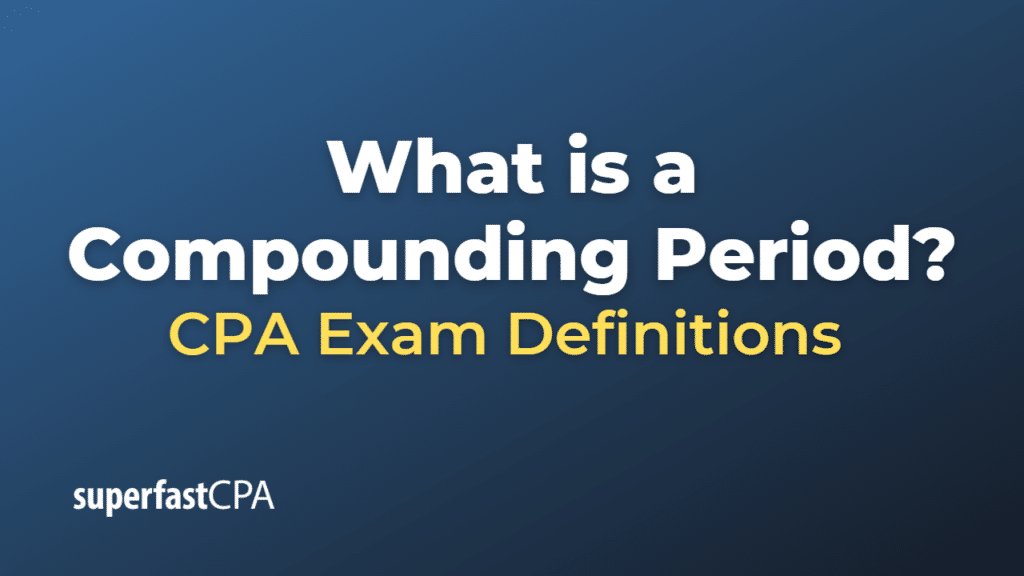Compounding Period
A compounding period, also known as the compounding frequency, is the length of time between when interest is calculated and added to the principal balance of an investment or loan. The interest earned during each compounding period is added to the principal, and from that point forward, interest is calculated on the new, higher principal amount. This process continues for the duration of the investment or loan, leading to exponential growth in the case of investments or an increase in the total cost of borrowing in the case of loans.
The compounding period can vary depending on the specific terms of the investment or loan. Common compounding frequencies include:
- Annual compounding: Interest is calculated and added once per year.
- Semi-annual compounding: Interest is calculated and added twice per year.
- Quarterly compounding: Interest is calculated and added four times per year.
- Monthly compounding: Interest is calculated and added twelve times per year.
- Daily compounding: Interest is calculated and added every day.
The more frequently interest is compounded, the greater the overall return on investment or the total cost of borrowing. For example, an investment with a 5% annual interest rate compounded quarterly will yield a higher return than the same investment with the same interest rate compounded annually. Similarly, a loan with daily compounding will result in a higher total cost of borrowing than a loan with the same interest rate and annual compounding.
To compare investment returns or borrowing costs across different compounding periods, the concept of the annual percentage yield (APY) or the annual percentage rate (APR) can be used, as these metrics take compounding frequency into account and provide a standardized measure for comparison.
Example of a Compounding Period
Let’s consider a hypothetical example to illustrate how the compounding period impacts the growth of an investment.
Suppose you invest $1,000 at an annual interest rate of 6%. We will compare the future value of this investment after three years, using different compounding periods: annual, semi-annual, quarterly, and monthly.
- Annual compounding: The interest is compounded once per year. Using the compound interest formula:
\(A = P \left(1 + \frac{r}{n}\right)^{nt} \)
where:
- P (initial principal) = $1,000
- r (annual interest rate) = 0.06 (6% as a decimal)
- n (compounding frequency) = 1 (annual compounding)
- t (number of years) = 3
\(A = 1,000 \left(1 + \frac{0.06}{1}\right)^{1*3} = 1,000 \left(1.06 \right)^{3} = 1,191.02\)
- Semi-annual compounding: The interest is compounded twice per year.
- n (compounding frequency) = 2 (semi-annual compounding)
\(A = 1,000 \left(1 + \frac{0.06}{2}\right)^{2*3} = 1,000 \left(1.03 \right)^{6} = 1,194.92\)
- Quarterly compounding: The interest is compounded four times per year.
- n (compounding frequency) = 4 (quarterly compounding)
\(A = 1,000 \left(1 + \frac{0.06}{4}\right)^{4*3} = 1,000 \left(1.015 \right)^{12} = 1,196.71\)
- Monthly compounding: The interest is compounded twelve times per year.
- n (compounding frequency) = 12 (monthly compounding)
\(A = 1,000 \left(1 + \frac{0.06}{12}\right)^{12*3} = 1,000 \left(1.005 \right)^{36} = 1,197.63\)
In this example, you can see that the future value of the investment increases with more frequent compounding:
- Annual compounding: $1,191.02
- Semi-annual compounding: $1,194.92
- Quarterly compounding: $1,196.71
- Monthly compounding: $1,197.63
The more frequently interest is compounded, the greater the overall return on investment.













